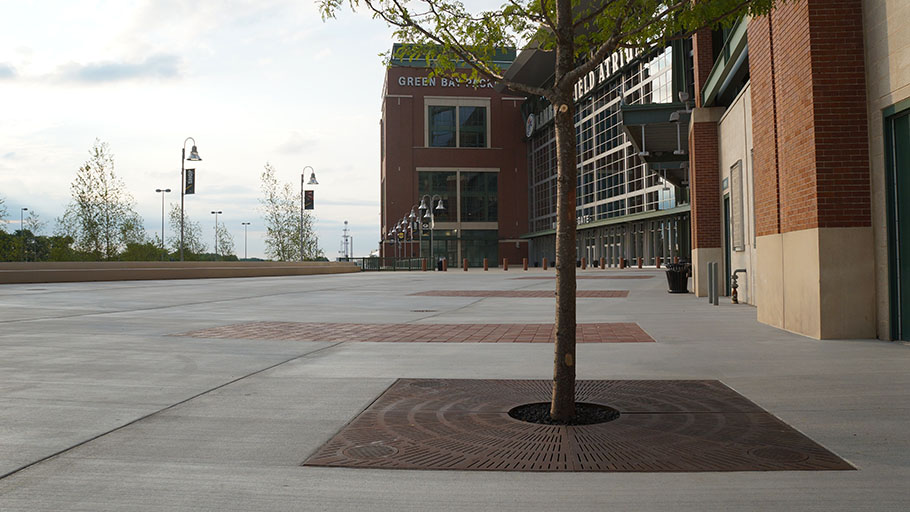Creating networks and building connections
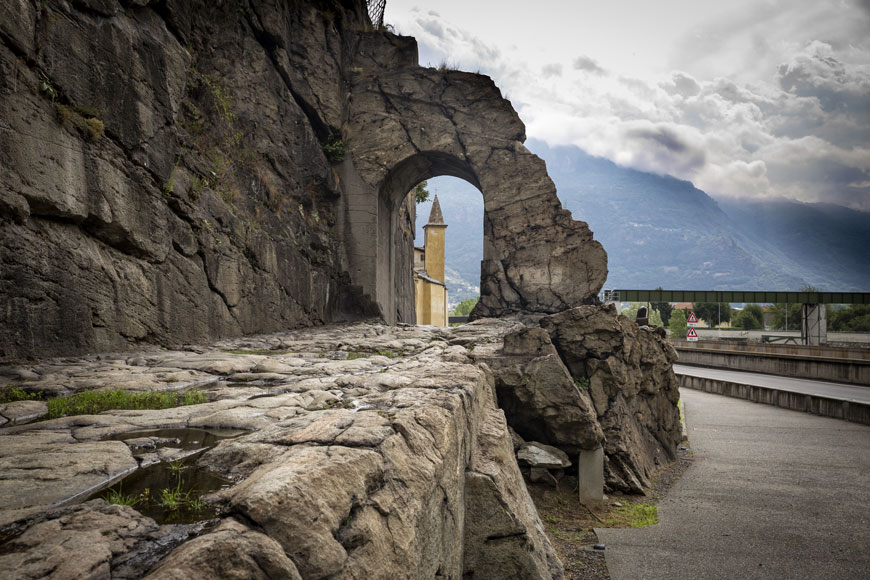
Infrastructure builds connections between human groups or activities. With infrastructure, people can work together and provide specialized services to one another. In this way, robust infrastructure supports complex societies.
Ancient infrastructure: When cow paths become roads
History’s earliest infrastructure projects were roads. Nomadic hunter-gatherer populations were builders—creating monuments of complexity like barrow mounds, stone tombs, geoglyphs, or stone circles—but creating and maintaining a system of roads would not have been worth the energy. Permanent infrastructure was less important than moving freely the herds. Roads became important after societies went through Agricultural Revolution. Settled communities built around farming needed clear, consistent routes for trading and traveling.
Early roads often arose out of the erosion patterns of well-travelled paths between settlements. Such tracks or trails still show up today in what is known in urban planning as “desire paths.” Erosion and defoliation caused by foot-fall, either human or animal, creates a trail. These trails are easier to navigate, and therefore get more use. Trails following this pattern often avoid geographical features like hills or bogs.
The Natchez Trace
One such trail, in use for thousands of years, is the Natchez Trace. In places a historic site, this trace still runs from Tennessee to Natchez, Mississippi. Originally it was a game trail created by large herds, primarily bison, as they moved through wooded undergrowth. Indigenous groups could follow the herds when hunting.
However, the societies in the area repurposed the trail for sacred sites. Artifacts show that trade and other social interaction happened along the trace. The Pharr Mounds, now 2000 years old, are major sites of construction that show the game trail evolved to become an important human road.
Sweet Track
As road-building became more formal, roads and bridges were constructed to deal with geological features, rather than skirting them. One example of Neolithic road-building is found in Somerset, UK, where the Sweet Track was created to form a trackway over a bog. The 1.25 mile stretch of path is created out of wood planks, balanced on crossed pegs over a base rail.
Sacbe or “White Road”
In pre-Columbian Mesoamerica, the Mayans built roads called “sacbe.” These roads were built of stone and paved with limestone. In cities, these connected building sites. Raised highways connected cities and were not just a path: they were also a monument to the power of a ruler and a source of local pride.
The Royal Road of Persia
Darius the Great was a Persian King between 522-486 BCE, who ruled at the height of the Persian Empire. Like the Romans that came after him, Darius invested in infrastructure. He built canals and roads throughout the provinces of his empire, which stretched from modern-day Iran to Egypt. Along these roads, he placed way stations, so that couriers and other people on state business could re-supply themselves. He connected and transformed existing roads into the Royal Road, the biggest route of its time. It stretched over 1677 miles from modern-day Turkey to Susa, near modern-day Shush, Iran.
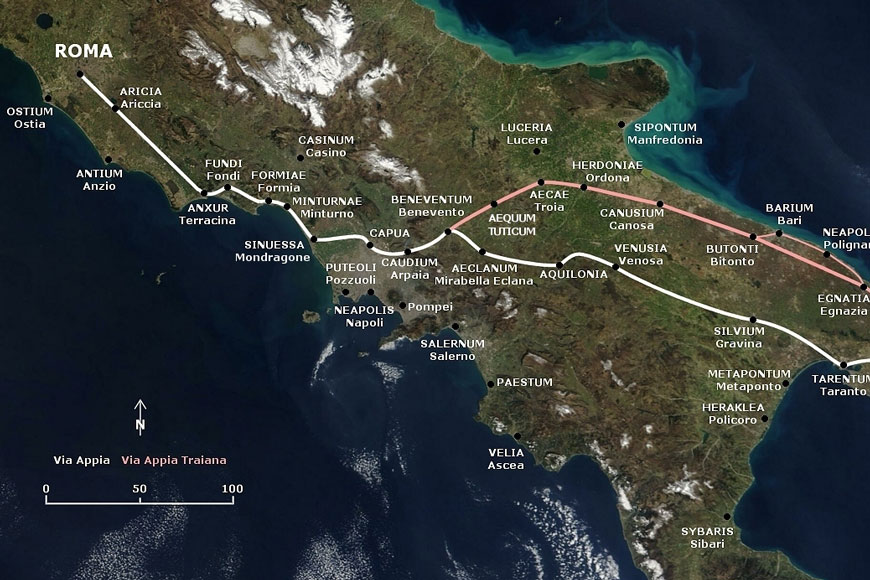
Roman roads
If roads had been built for centuries all around the world, why are the Romans famous for building roads?
The Romans believed infrastructure was of strategic importance: a way to move troops, supplies, and trade. During the Roman Empire’s ascendance, they built or upgraded 80,000 km (50,000 miles) worth of highways. This included resurfacing the Persian Royal Road. Further, they took road engineering very seriously: they believed in building straight, stable routes between points. Geographic hazards were managed rather than built around. Roman engineers were not afraid of draining a marsh, diverting a stream, or cutting into a mountain.
Roman road-builders used a concrete made of ash and lime to create smooth surfaces. Roads were standardized to 4.2 meters (4.6 yards) wide to allow traffic in both directions. Further, infrastructure improvements like a slight incline to allow water run-off was standardized. Roman infrastructure was integral to its historical dominance.
Aqueducts and water-mains
As with roads, the Roman empire is often associated with aqueducts. Here again, Roman engineers improved on existing designs.
For much of human history, towns and cities got water through rivers, streams, wells, and privately held cisterns. People were responsible for finding their own water supply. Competition and single-household seeking limited the number of people that could live in an area. Along rivers, heavy upstream use would lead to the spread of disease and pollution.
The Roman government saw public works as benefiting its empire. It set out an ambitious aqueduct policy and built 485 miles of aqueducts into surrounding lakes and mountains, bringing 11 billion gallons of water per year into the city.
Supplying and treating water is of vital importance to complex societies. Without relatively simple access to clean water, a large population cannot sustain itself. If the citizens of any region are invested in finding and treating water for themselves, their energy is absorbed by competition and lack. Major cities therefore invest in public water treatment and watermains to supply homes and businesses.
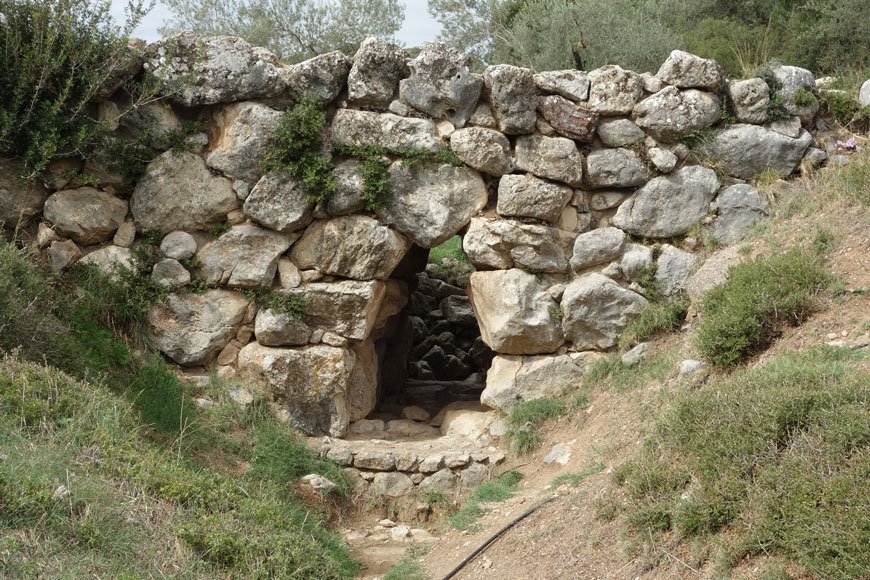
Waterways, bridges, and ports
Civilizations need potable water as a resource, but also must cross bodies of water for transport. Ferries, ports, and bridges are an essential part of any large infrastructure network.
People have been setting out over water through all of pre-history. There is some evidence that Homo erectus crossed water to settle on the Indonesian island of Flores 900,000 years ago. The oldest recovered boat is the Pesse Canoe, a 10,000-year-old dugout canoe found in the Netherlands.
Infrastructure, however, is produced by a society working together. These public projects enrich the group, rather than the individual. The Arkadiko Bridge in Greece, an arched bridge made of stone and built in the Bronze Age, is the oldest surviving stone bridge still in use today. It was part of a stone highway built between Tiryns and Epidauros as part of a military road network.
Ancient Greek mythology brings us the ferryman Charon, said to take souls to the Underworld. Here, even the afterlife has needed infrastructure. Ferries and ships are often privately owned, but they are given permission and often dock space by society. The oldest found port in the world is 4,500 years old, at Wadi al-Jarf in Egypt: artifacts show that it was an important trading port for Egypt’s Fourth Dynasty.
Lighting grids
As far back as the 4th century, in Antioch, private establishments have hung lanterns outdoors. Busy streets had illumination all night. In London and Paris, it was even a requirement: the cities demanded private citizens cast light outside their homes. But it wasn’t until 1594 when lighting could be properly considered infrastructure, when it became more than an individual concern. That year, the Parisian police force installed a network of lanterns in the hope that outdoor lighting at night would deter crime.
In the 1700s, lighting grids became public works. Teams of lamplighters roamed the city streets to fill and light oil lights held high on poles to cast a wide light. Eventually, whale-oil lamps gave way to gas, and then to electrical lighting. Street lighting is now an assumed part of modern infrastructure spending.
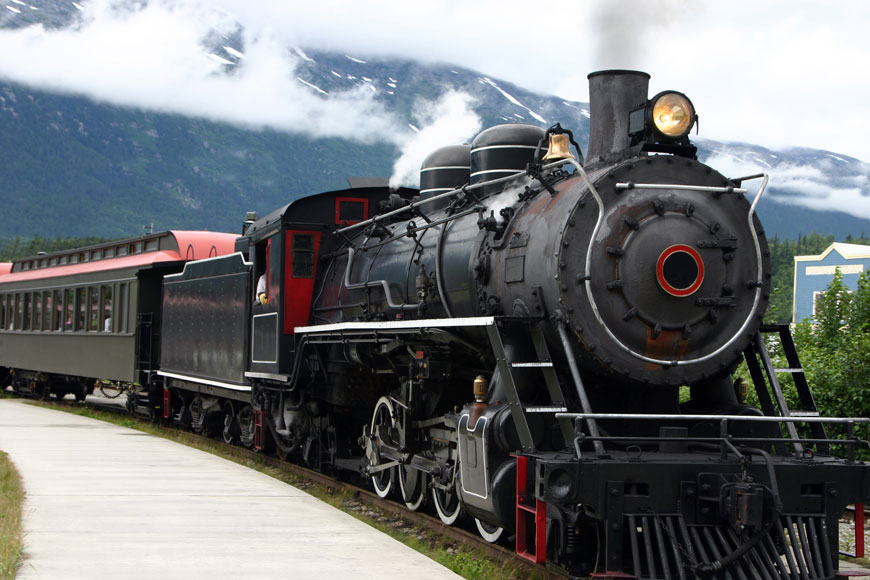
Railways
The first “railway” was a paved track for transporting boats and/or cargo across the Isthmus of Corinth in Greece. Grooves in the paving prevented wheeled carts from straying from the track. This early rail design certainly counted as important infrastructure at the time. Yet it was the steam engine that made rail systems really matter to economic development.
In 1857, steel rails were laid in Derby, England; ever after, the carrying power of the locomotive allowed supply networks to expand and grow. If trains are held by private companies, railroads are often public, since the network of land needed to build a comprehensive line can be expensive.
Railroad infrastructure was the catalyst behind the explosive growth of the North American economy in the 19th and 20th centuries.
Electrical grids
Philosophers and scientists have long observed electricity in nature, be it electrical eels or static electricity. Serious study of electricity started in the 1600. Observances of static electricity, magnetism, and the invention of the Leyden jar as an electrical storage device in 1745. Then in 1752 Benjamin Franklin ran his famous key and kite experiment to show lightning was electrical in nature. He came up with a theory to describe his observations using positive and negative charges. A rush of scientific enquiry followed. Soon the electron was captured as a way to transfer energy. At first electricity was generated right next to the device it would power.
1901 saw the creation of the first electrical power station, in Newcastle upon Tyne, England. Public subsidy of power generation and transmission become worthwhile for most societies. Electricity allowed for greater productivity in almost every sector. As with rail lines, roads, and ferry ports, electrical infrastructure made the whole society more effective. Electrical poles and lines became a public concern. Private generation is common, but electrical grids are sometimes publicly held. When they are not, they generally fall under legislative frameworks that give the government greater access to them.
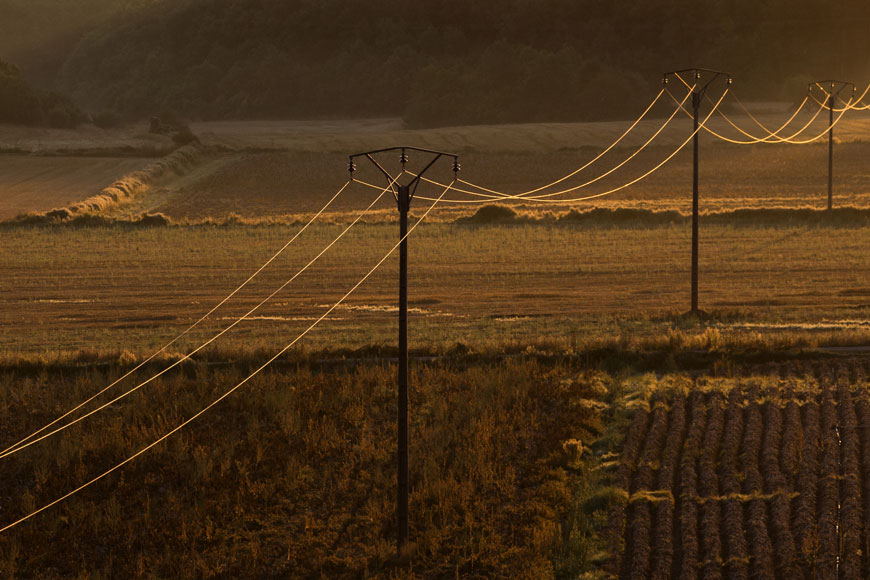
Telecommunications and radio infrastructure
Telecommunications were the next innovation in infrastructure. Electrical telegraph networks were invented in 1816 by Francis Ronalds. However, the idea was so new it was originally dismissed as not worth the effort; it took 20 years for the idea to catch on. Short messages shot through wires seemed like too much work for too little payoff to an unwired society. However, the telegraph paved the way for a new way of thinking about information.
After radio waves were identified, it took ten years for inventor Guglielmo Marconi to figure out how to use them for broadcast. Five short years later, the first commercial applications rolled out. The world was ready for instantaneous long-distance communication.
Due to the nature of radio towers, public and private transmission can co-exist easily. Unlike roads, which take up land, signals can lie one on top of the next. Radio infrastructure exist in protocol and licensing: who uses what band and when. Governments have and protect their own radio networks, both one and two ways, including broadcast towers. These are important for military, educational, and public uses.
Telecommunications infrastructure includes radios, phone lines, fiber optic, cellular networks, and more. Societies are extremely dependent on good communication systems for security, privacy, economic opportunity, and emergency response. Legislation, licensing, and public ownership generally manage this infrastructure to make it available to as many as possible.
The Internet
The internet is owned by no-one: it is a group of small digital networks that link together to make a larger whole. These networks communicate, however, on telecommunications networking.
Computer networks have infrastructure that echoes transportation networks. Servers, switches, and routers move information from one place to another, rather than goods or people. The internet is a system of private networks hooked together over telecommunications networks. Individual ISPs, or internet service providers, lease space over phone lines. They are like the shipping company that owns trains and pays to access railways to deliver their goods.
Phone providers are also sometimes private companies. Therefore, telecommunications and digital infrastructure, although important to the common good, have a different model than those of roads and bridges.
How societies might harness the power of networking is still being explored. Like those who saw the idea behind telegraphs but could not imagine how they might be useful, we still do not fully envision the power of our networks.
Societies are still exploring the potential behind ideas like the Internet of Things, Smart Cities, and autonomous vehicles. If these innovations help a society become more productive or functional, they may end up becoming as important as roads are today.

Infrastructure allows for complexity
Throughout history developments in infrastructure have supported the growth of complex, integrated societies. With infrastructure in place, groups can specialize and trade more efficiently. Historically, new public infrastructure developments have often supported advances in civilization. These disruptions have been caused by:
- Ancient roads
- Aqueducts and water-mains
- Waterways, bridges, and ports
- Lighting networks
- Railways
- Electrical grids
- Telecommunications and radio infrastructure
- The Internet
People, information, resources, and goods flow from one part of an economy to another via public infrastructure.
Infrastructure generally connects people with increased ease, speed, and efficiency. Yet, today, we are at something of an inflection point. Congestion in physical space is becoming a problem for our crowded urban societies. We have studies that show that adding infrastructure, like adding a lane to a busy highway, often leads to the same amount of congestion by inducing demand. Infrastructure encourages movement. We now have mobility our ancient ancestors couldn’t have imagined. As we run up against the limits of available space, cities are beginning to bet on smarter infrastructure, rather than more infrastructure.
Strategic planning in a modern city is often about re-establishing the village center that infrastructure took away. Revitalizing neighborhoods means providing the jobs and amenities close to home. Complexity for its own sake is not as important as smooth function.
In computer science, the concept of elegance pairs effectiveness and simplicity. Computer networks now have the capability of handling thousands of lines of code. This can lead to code bloat—more throughput means that programmers are less careful about preserving space. Yet coders know that elegance and simplicity make a system more robust. Plus, using a resource well leads to spectacular innovation. Similarly, in human networks, success may come through more effective function, rather than creation of more capacity.
Smart cities and the internet of things may be part of this. So is placemaking: creating livable, enjoyable spaces where people come to live, work, and innovate.











